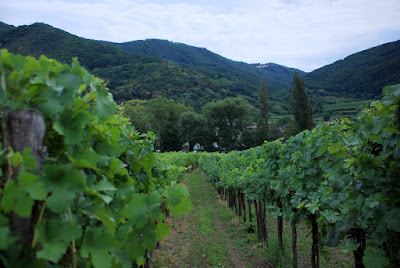Blog is better read in chronological order. Previous posts:
- The route
- Day 1. Die Hängebrücke
- Day 2. Conquering two peaks
- Day 3. Glacier lakes and a small miracle
- Day 4. From the top of the mountain to the depth of the earth
- Day 5. Berchtesgaden. Rossfeld route. Malenwinkler rund.
- Day 6. Klagenfurt
- Day 7. Design city. Schwarzenegger's heritage.
- Day 8. South to North.
The next two days did not produce many pictures since we were busy - the first day - biking, the second one - driving.
Melk abbey is built on the high bank of the Danube river in Wachau, close to the famous wine valley. Cruise boats go up and down Danube, stopping at Melk and many other small beautiful towns and villages in this area. The wine valley can be explored hopping on and off the boat, driving by car or riding by bike. We took a bike downhill from Melk to Krems and then a boat back upstream.
Closer to the end of the valley, Dürrstein is the nicest town of them all.
The view to Danube from the town walls is amazing.
The narrow streets are filled with local restaurants and shops offering apricot (Marillen) products from jams to liquors and wines from the hills around.
We happened to be in the region in the apricot and chanterelle season and almost every restaurant served fresh chanterelle dishes as part of their tageskarte and there were places along the road where you could buy fresh delicious apricots just picked from the trees around.
Danube is busy with cruise and cargo ships going up and down the river.
Melk abbey is built on the high bank of the Danube river in Wachau, close to the famous wine valley. Cruise boats go up and down Danube, stopping at Melk and many other small beautiful towns and villages in this area. The wine valley can be explored hopping on and off the boat, driving by car or riding by bike. We took a bike downhill from Melk to Krems and then a boat back upstream.
The recommended bike route goes on the north side of Danube and the first couple of villages are not that remarkable.
Then the vineyards start - steep long terraces with vines, formed by mountains, silt, Danube and human hands - interrupted by small cosy villages and wineries.
Bike trail wound among the vines, mostly downhill, sometimes going up, busy with bikers traveling in both directions. The route is extremely popular among bike tourists, riding their bikes loaded with backpacks and probably staying in small villages along the way.
Slightly higher went along the touristic railroad - Wachaubahn.
Weissenkirchen is a small village featuring a church with white tower (Weissenkirchen means "white church"). Besides vineyards surrounding it, if you want to learn more about Wachau region, you can visit Wachaumuseum situated here.
Closer to the end of the valley, Dürrstein is the nicest town of them all.
The narrow streets are filled with local restaurants and shops offering apricot (Marillen) products from jams to liquors and wines from the hills around.
We happened to be in the region in the apricot and chanterelle season and almost every restaurant served fresh chanterelle dishes as part of their tageskarte and there were places along the road where you could buy fresh delicious apricots just picked from the trees around.
We left bikes in Krems and landed in a riverside cafe waiting for the boat. At the next table a small cutie waited for the boat as well..
Danube is busy with cruise and cargo ships going up and down the river.
Not only people, but buildings themselves on Danube shores are very friendly and welcoming...
On the next day before driving off to Wolfgangsee we came back to Wachau valley to admire its atmosphere again and taste the local wines (the idea of tasting it while riding bikes did not seem great to us yesterday). We found a nice vinotek around Weissenkirchen with a shady garden...
... romantic pavillion for one ...
... and a couple of aboriginal sparrows, who didn't mind posing for the camera ...
With this the Wachau visit was completed and we drove off to north-west Austria for some more hiking.




















































